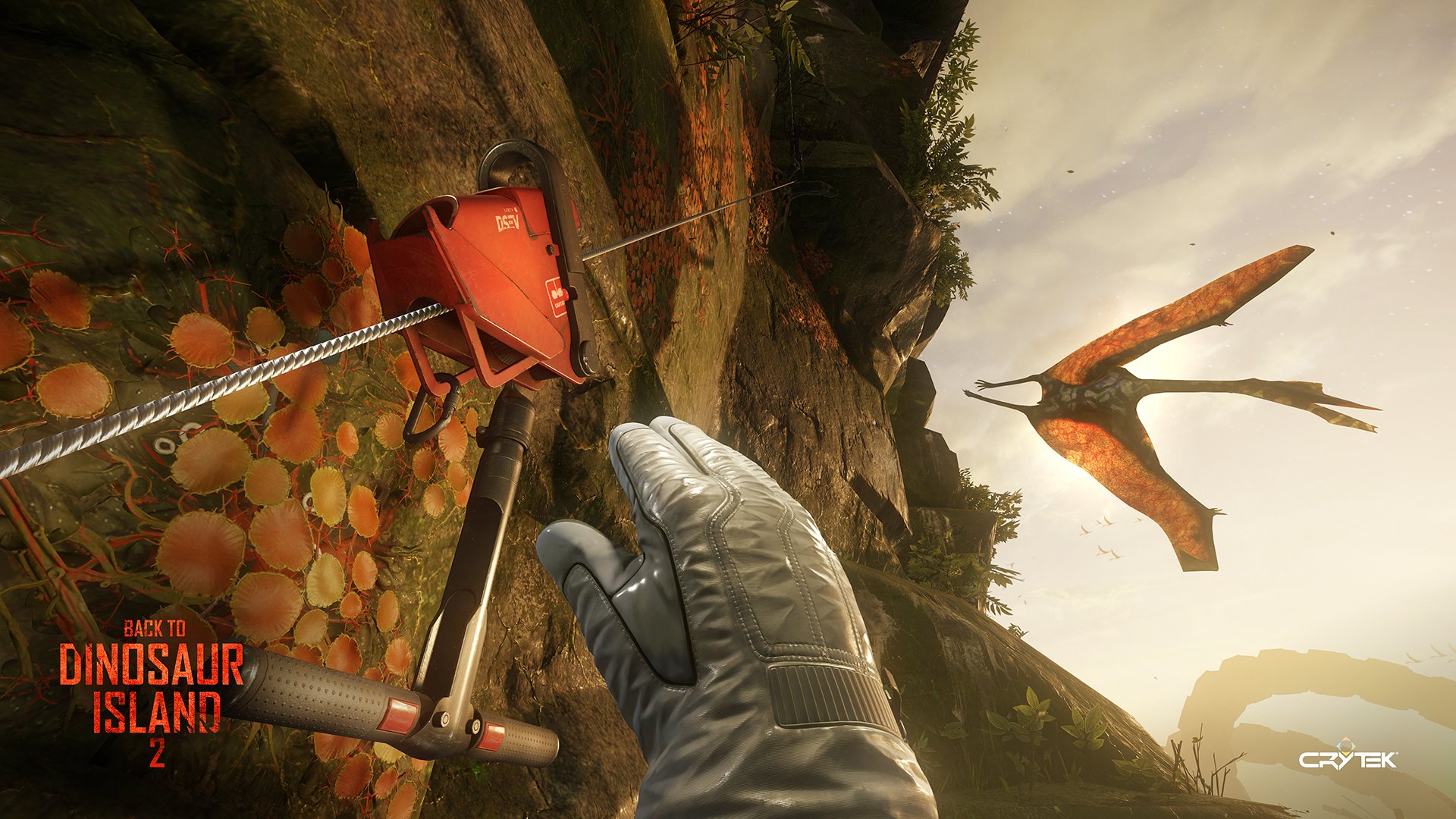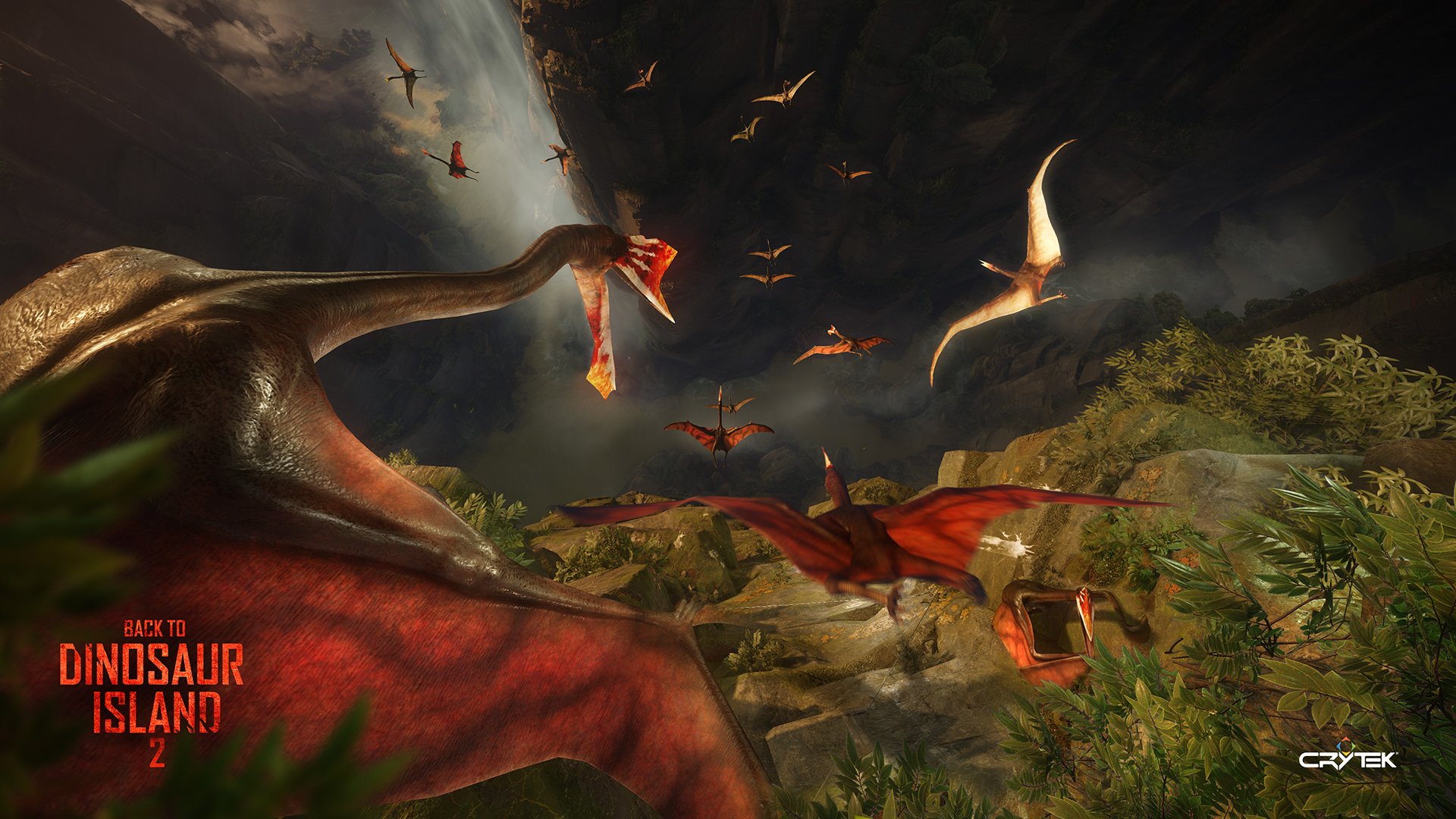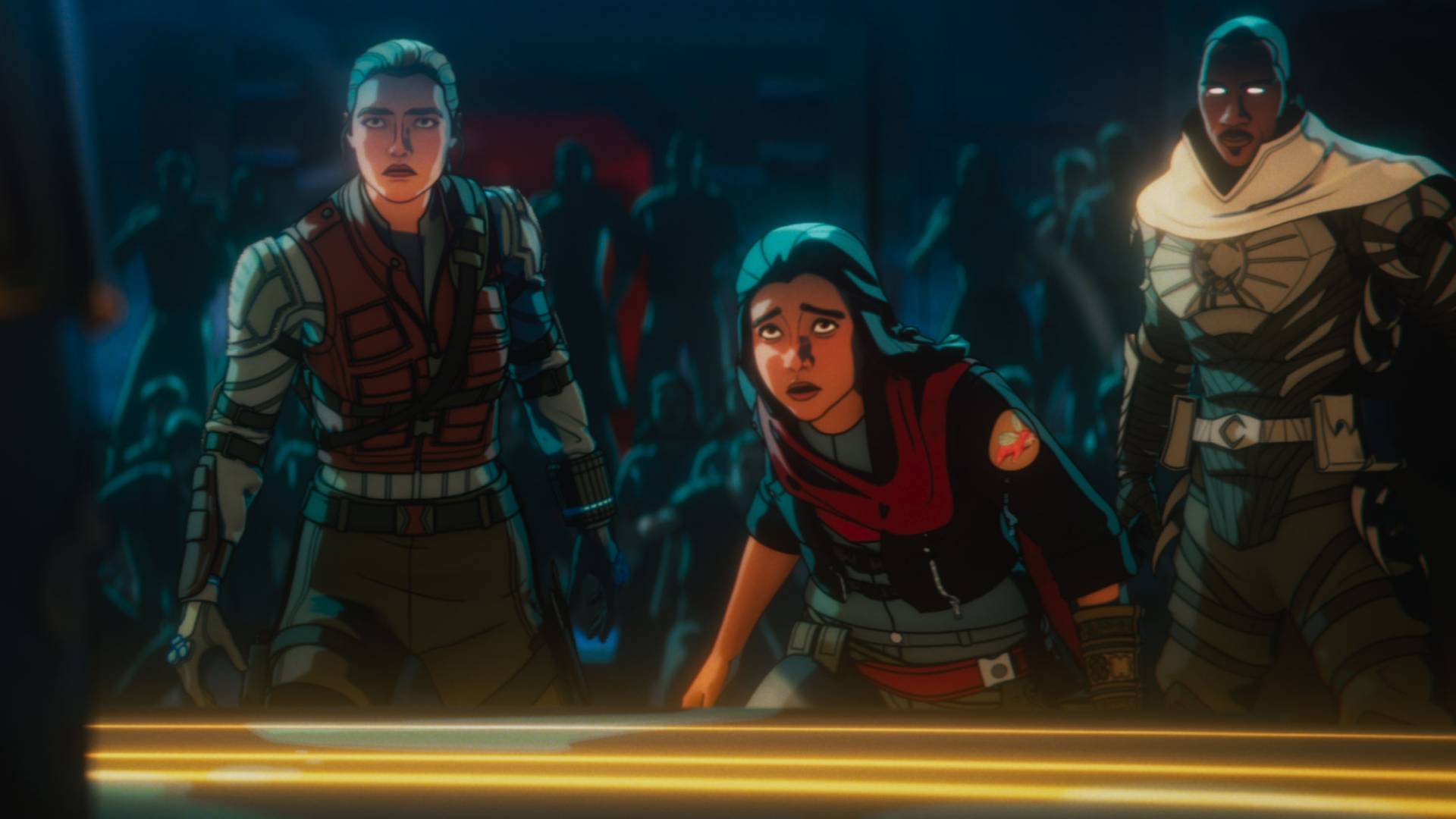I have seen the future of VR and it is pterodactyls dropping rocks on my head
Listening to the recording I made of myself playing Crytek’s Back to Dinosaur Island 2, there’s a noise I don’t fully remember making. It’s a sort of quietly strangled laugh, like I’d thought of a great joke underwater, come up for air and inhaled a small swarm of flies. It’s the sound of a man afraid, but unwilling to admit it, and trying vainly to force out exactly the opposite reaction.
Listening to that recording, I know what was happening in my demo, because a nice German man swiftly replies by whispering into my ear, “now there is some rocks falling on you. You can dodge them.” I remember this bit, because in my worry at headbutting a nice, whispering German to death in my literal blind terror, I sat still and got hit by several more rocks, creaking out another half-laugh each time, an escalating chorus of emphysemic choir-frogs, until I was sure his German head was safely away from my thick, trembling skull.

This is VR’s great trick, of course, the ability to replicate involuntary sensations in your body by making your brain almost positive that it is about to be carked out against its will. A stomach-tightening drop, a twitching neck-dodge - the first time I used an Oculus Rift I was standing up during a space combat game and immediately fell backwards upon seeing my player-character’s legs in a seated position. My brain told me things my limbs wouldn’t, and I accidentally did a trust exercise with all the strangers behind me. Luckily, I clearly seem trustworthy - which isn’t even true because I will try to laugh in front of you even if, inwardly, I’m scared you’ve caused me to be hit by rocks. What I’m saying is that brains are idiots, and that’s precisely why VR is such good fun.
It’s most often a resolutely non-interactive kind of good fun, however. The majority of VR games fall into two camps; either 10-minute thrill rides - lonely, portable theme park simulators that trade on their visceral effects but can’t yet offer much more - or the sort of thing that just turns your head into a camera to offer a tad more control and immersion. The idea of travelling around Skyrim or Rapture from a VR perspective is enticing, but needing to use a full controller blindly at the same time would sour the experience, like playing a football match where the only way of kicking the ball is by using a complex pulley system located on the inside of your shorts. A full VR game requires a new kind of thinking around your interaction with it.
"Brains are idiots, and that’s precisely why VR is such good fun."
Back to Dinosaur Island 2 seems to fall firmly into the theme park camp - but comes with some caveats. The demo sees you travelling up the sheer face of a cliff, using mechanised, handheld winches to wind you slowly up - inadvertently startling the pterodactyls nestling among its crags and crannies. A couple poke their beaks out and screech to startle you at the beginning, followed by the sight of a family unit taking their first flight together, before what I’m guessing (hoping) is an alpha starts the dreaded rock incident.
You get the gut-churning “don’t look down” effect, and a neat use of 3D audio to startle you once with the screech of a leathery bird-thing, and again when you turn round and see right down its gross mouth. Rendered in CryEngine, it’s certainly beautiful, a prehistoric sci-fi vista that demands you crane around like a wowed tourist giraffe to take it all in.

There are some more game-y elements hidden in here, however. For one, you’re controlling your ascent using two disembodied hands, which you align by looking at where you want them to go, and gripping onto various, separate winch controls using the left and right triggers of a standard controller (apparently, if you let go of both triggers, you plummet to the bottom of the cliff - I didn’t want to test this). Think of it as playing as the Surgeon Simulator guy’s more dextrous sibling, who runs a boutique adventure holiday business.
Weekly digests, tales from the communities you love, and more
Then there’s that rock-dodging, something that requires careful use of the winches and some emergency head-jerks to achieve. When you do reach the top of the cliff, you’re treated to a view over a primeval landscape, and the ability to scan elements of it using the sheer power of “looking slightly above them” - suggesting this how you’ll choose how to travel around a game-world that doesn't yet exist.

It’s hardly the bewildering, overlapping cogs behind a Platinum game, but it’s a step ahead of many of its peers in terms of your control over it. And that’s very much the point. This demo was created specifically to see if more meaningful interactions like climbing and scanning would work in VR, with a view to creating Robinson: The Journey, Crytek’s first VR-only full game.
“Those are just two small proof-of-concept elements that will be part of the experience in Robinson,” explains director of production, David Bowman. “It takes place on a planet that has creatures that resemble Earth dinosaurs, it has exploration, lots of figuring out what's going on, what happened, how to solve being where you don't want to be. We already have - but we aren't showing yet - a bunch of mechanics that are involved in that. What you saw were a couple of elements that were the most compelling for a short demo.”
"The first time we let you fall, it was really cool, but your brain went ‘oh my God, this is really bad, what's happening to me?’"
Bowman’s masterfully evasive about discussing any specific details about Robinson, and how it really relates to either Back to Dinosaur Island demo (the first was less involved, casting you as a basically immobile baby reptile, and featured a T-Rex that mirrored your head movements), but his passion is clear. Often leaning forward and giving me a look not unlike the curious, easily angered creatures of his demos, he explains how “intimacy” (a real-world sense of connection to the environment, the idea that you can move right next to any object and inspect it) and “presence” (basically, making me make a sound like a prop comedian had just performed a stupendous trick with some bratwurst, but got one lodged up my sinus as I reacted) are the base benefits of VR, and that the skill is in making those work alongside interaction.
Letting go of the winches and falling in the demo is, as it turns out, a key part of the proof-of-concept here (my bad): “If you'd been there for the first 19 versions of this demo, you would have been... uncomfortable”, says Bowman. “The first time we let you fall, you hit the ground and bounced around. It was really cool, but your brain went ‘oh my God, this is really bad, what's happening to me?’ and your ear is going ‘nothing's happening to me’. So there's a dysmorphic feeling, which is the disconnect between one part of your body saying one thing and the rest of your body saying that's not true. That will make you sick, really, really quickly. You need respect for the camera, respect for the player's inner ear. That's an example right there - we went through 20 iterations of ‘how do we fall without making people sick?’”

It’s clearly a fraught process (incidentally, QA testers have suddenly been elevated to vomit-stained heroes in my eyes), and it’s absolutely not clear how multiple VR-friendly interactions can be gelled together to make a cohesive single game that doesn’t also make your body twist inside-out with confusion. You worry that it could become a cobbled-together Mario Party of reptile-laden VR mini-games, but there’s an intent in the way Bowman talks about his project, a confidence as he explains that games like his will make these new peripherals not only successful, but wildly popular, a new mainstream accessory on par with the mobile phone - it suggests that the team has plans and ideas we simply can’t fathom at this point, not until we’ve played it ourselves.
Back to Dinosaur Island 2 isn’t the future of VR gaming, but its ideas and effects - those takes on movement, scale, interaction and the ability to make a grown man with a laser brick on his head make sounds so alien that he has to sum them up in dreadful, extended similes - point to something that very much could be. I have no idea what it will be, but I look forward to finding out what other sounds my body can create when faced with it.



